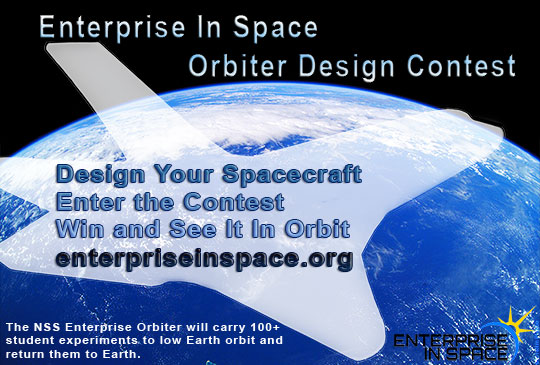
NSS Enterprise in Space Orbiter Design Contest
The NASA Space Shuttle Enterprise never made it to orbit. While that was the original intent, subsequent redesigns undertaken during the Enterprise testing phase made this impractical.
Most tragically, another Enterprise – Virgin Galactic’s VSS Enterprise, crashed in the Mojave Desert on October 31, 2014 – a crash in which co-pilot Michael Alsbury lost his life. VSS Enterprise had undertaken more than thirty successful test flights and was the first of five planned suborbital spacecraft to be used to send tourists and experiments on suborbital trips to space.
Unfortunately the news media focus on the space tourism aspect of companies like Virgin Galactic and XCOR Aerospace while largely ignoring the fact that these spacecraft will be important platforms for conducting a wide variety of experiments in a microgravity environment.
But suborbital is not orbital. With luck and public support the first Enterprise to orbit the Earth will be the NSS Enterprise Orbiter which will carry approximately 100 competitively selected student experiments into low Earth orbit and after a week’s time return them safely to Earth.
Before the Enterprise can be built it must be designed. And this is where you can help. One feature of this program is that the Enterprise in Space team is calling on artists, engineers, science fiction fans, students, designers, space activists, and dreamers to come up with their own concept of what the NSS Enterprise Orbiter should look like. And unlike the overwhelming majority of art, graphics, and design contests that require entrants to pay a submission fee, entry in the Enterprise in Space Design Contest is free!
If designing spacecraft isn’t for you then you can support the Enterprise in Space project by:
- sharing news of the project with your friends.
- liking the Enterprise in Space project on social media (see the Enterprise in Space web site for social media information)
- sharing the graphic used for this post to spread the word about the contest (you can download a larger wallpaper version of the contest ad here.
- donating to the EIS campaign – with a $20 donation getting your name onboard the NSS Enterprise Orbiter as a virtual crew member. For details see the Enterprise in Space Donation Page.
As the newly appointed manager for the EIS Orbiter Design Contest I offer the following basic tips for those entering the contest.
My first tip is to do it. Not only are there some great prizes for the contest winner but the winner will have a place in the history of private/personal space exploration.
My second tip is that you don’t have to be a master of 3D or CAD software. I’ll remind you that such software is a very recent invention. It’s the design that counts and that can be illustrated using nothing more complex than paper, pencil, and ruler.
Third is to follow the rules. An important rule is to not design a spacecraft that looks like a spacecraft that is associated with a spacecraft from TV or film. It must be your own original design.
Fourth is to be mindful that the spacecraft you design will be housing somewhere around one hundred student experiments. That means avoiding a design that minimizes internal volume. Once manufactured, your orbiter will physically have as its maximum dimensions 8 feet by 8 feet by 6 feet so be mindful of the factors 8 x 8 x 6 in designing your craft.
So now is the time to either fire up your favorite graphics software or grab your drafting supplies and get to designing a spacecraft that is truly unique. The submission deadline is fast approaching so don’t delay.
Lastly, I would like to wish everyone entering the contest the best of luck and I look forward to seeing the designs you create.
Ad Astra, Jim Plaxco; Manager, Enterprise in Space Orbiter Design Contest


















